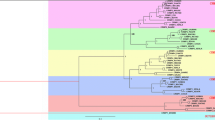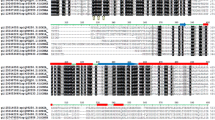Abstract
As monogenic forms of episodic nervous system disorders are often caused by ion channel mutations, we looked for features of human central nervous system (CNS) expressed ion channels that further our understanding of those phenotypes. To this end, we compared human ion channels with other CNS-expressed genes, which we categorized according to the existence of transmembrane domains. When looking at the phylogenetic distribution of these genes, we observed an increased percentage of ion channels that exist in vertebrate genomes while missing in invertebrate genomes. Because we hypothesized that this pattern may relate to a more specific expression, we searched for characteristics of ion channels that indicate a tighter expression regulation. We found that ion channels have longer intron and protein sequences, features typical of genes with more specific expression. In addition, ion channels have increased human–rodent conservation around their transcription start site, as indicated by a higher fraction of conserved noncoding regions. This points to a high relevance of mutations that regulate ion channel expression. When we finally asked whether vertebrate-specific diversification is also displayed by non-ion channel genes with important roles in the CNS, we found a similar phylogenetic distribution. This concordant phylogenetic pattern suggests that vertebrate-specific adaptations may account for a large part of the shared genetic basis of episodic CNS disorders, including monogenic and genetically complex disease manifestations. Consequently, this phylogenetic pattern may contribute to the prioritization of candidate genes in human genetic studies of episodic CNS disorders.


Similar content being viewed by others
References
Ptacek LJ, Fu YH (2004) Channels and disease: past, present, and future. Arch Neurol 61(11):1665–1668
Haut SR, Bigal ME, Lipton RB (2006) Chronic disorders with episodic manifestations: focus on epilepsy and migraine. Lancet Neurol 5(2):148–157
Ptacek LJ (1997) Channelopathies: ion channel disorders of muscle as a paradigm for paroxysmal disorders of the nervous system. Neuromuscul Disord 7(4):250–255
Cooper EC, Jan LY (1999) Ion channel genes and human neurological disease: recent progress, prospects, and challenges. Proc Natl Acad Sci USA 96(9):4759–4766
Kullmann DM (2002) The neuronal channelopathies. Brain 125(Pt 6):1177–1195
Meisler MH, Kearney JA (2005) Sodium channel mutations in epilepsy and other neurological disorders. J Clin Invest 115(8):2010–2017
Levitan IB (2006) Signaling protein complexes associated with neuronal ion channels. Nat Neurosci 9(3):305–310
Delmas P, Brown DA (2005) Pathways modulating neural KCNQ/M (Kv7) potassium channels. Nat Rev Neurosci 6(11):850–862
Antonarakis SE, Beckmann JS (2006) Mendelian disorders deserve more attention. Nat Rev Genet 7(4):277–282
Peltonen L et al (2006) Lessons from studying monogenic disease for common disease. Hum Mol Genet 15(Spec No 1):R67–R74
Gargus JJ (2006) Ion channel functional candidate genes in multigenic neuropsychiatric disease. Biol Psychiatry 60(2):177–185
Hubbard T et al (2005) Ensembl 2005. Nucleic Acids Res 33(Database issue):D447–D453
O’Donovan C, Apweiler R, Bairoch A (2001) The human proteomics initiative (HPI). Trends Biotechnol 19(5):178–181
Camon E et al (2004) The Gene Ontology Annotation (GOA) database: sharing knowledge in Uniprot with gene ontology. Nucleic Acids Res 32(Database issue):D262–D266
Krogh A et al (2001) Predicting transmembrane protein topology with a hidden Markov model: application to complete genomes. J Mol Biol 305(3):567–580
Su AI et al (2004) A gene atlas of the mouse and human protein-encoding transcriptomes. Proc Natl Acad Sci USA 101(16):6062–6067
Kent WJ et al (2005) Exploring relationships and mining data with the UCSC Gene Sorter. Genome Res 15(5):737–741
Enright AJ, Van Dongen S, Ouzounis CA (2002) An efficient algorithm for large-scale detection of protein families. Nucleic Acids Res 30(7):1575–1584
Blomme T et al (2006) The gain and loss of genes during 600 million years of vertebrate evolution. Genome Biol 7:R43
Yang Z (1997) PAML: a program package for phylogenetic analysis by maximum likelihood. Comput Appl Biosci 13(5):555–556
Schwartz S et al (2003) Human–mouse alignments with BLASTZ. Genome Res 13(1):103–107
Freudenberg-Hua Y et al (2005) Systematic investigation of genetic variability in 111 human genes—implications for studying variable drug response. Pharmacogenomics J 5(3):183–192
Prabhakar S et al (2006) Close sequence comparisons are sufficient to identify human cis-regulatory elements. Genome Res 16(7):855–863
Harris MA et al (2004) The Gene Ontology (GO) database and informatics resource. Nucleic Acids Res 32(Database issue):D258–D261
Liu Y, Gerstein M, Engelman DM (2004) Transmembrane protein domains rarely use covalent domain recombination as an evolutionary mechanism. Proc Natl Acad Sci USA 101(10):3495–3497
Bargmann CI (1998) Neurobiology of the Caenorhabditis elegans genome. Science 282(5396):2028–2033
Rubin GM et al (2000) Comparative genomics of the eukaryotes. Science 287(5461):2204–2215
Hedges SB (2002) The origin and evolution of model organisms. Nat Rev Genet 3(11):838–849
Prachumwat A, Li WH (2006) Protein function, connectivity, and duplicability in yeast. Mol Biol Evol 23(1):30–39
Vinogradov AE (2004) Compactness of human housekeeping genes: selection for economy or genomic design? Trends Genet 20(5):248–253
Eisenberg E, Levanon EY (2003) Human housekeeping genes are compact. Trends Genet 19(7):362–365
Winter EE, Goodstadt L, Ponting CP (2004) Elevated rates of protein secretion, evolution, and disease among tissue-specific genes. Genome Res 14(1):54–61
Zhang L, Li WH (2004) Mammalian housekeeping genes evolve more slowly than tissue-specific genes. Mol Biol Evol 21(2):236–239
Drummond DA, Raval A, Wilke CO (2006) A single determinant dominates the rate of yeast protein evolution. Mol Biol Evol 23(2):327–337
Sironi M et al (2005) Analysis of intronic conserved elements indicates that functional complexity might represent a major source of negative selection on non-coding sequences. Hum Mol Genet 14(17):2533–2546
Marcotte EM et al (2000) Localizing proteins in the cell from their phylogenetic profiles. Proc Natl Acad Sci USA 97(22):12115–12120
Hattori E et al (2005) Genetic tests of biologic systems in affective disorders. Mol Psychiatry 10(8):719–740
Kalachikov S et al (2002) Mutations in LGI1 cause autosomal-dominant partial epilepsy with auditory features. Nat Genet 30(3):335–341
Skradski SL et al (2001) A novel gene causing a Mendelian audiogenic mouse epilepsy. Neuron 31(4):537–544
Lee HY et al (2004) The gene for paroxysmal non-kinesigenic dyskinesia encodes an enzyme in a stress response pathway. Hum Mol Genet 13(24):3161–3170
Suzuki T et al (2004) Mutations in EFHC1 cause juvenile myoclonic epilepsy. Nat Genet 36(8):842–849
Owen MJ, O’Donovan MC, Harrison PJ (2005) Schizophrenia: a genetic disorder of the synapse? BMJ 330(7484):158–159
Kirov G, O’Donovan MC, Owen MJ (2005) Finding schizophrenia genes. J Clin Invest 115(6):1440–1448
Plummer NW, Meisler MH (1999) Evolution and diversity of mammalian sodium channel genes. Genomics 57(2):323–331
Piontkivska H, Hughes AL (2003) Evolution of vertebrate voltage-gated ion channel alpha chains by sequential gene duplication. J Mol Evol 56(3):277–285
Anderson PA, Greenberg RM (2001) Phylogeny of ion channels: clues to structure and function. Comp Biochem Physiol B Biochem Mol Biol 129(1):17–28
Strong M, Chandy KG, Gutman GA (1993) Molecular evolution of voltage-sensitive ion channel genes: on the origins of electrical excitability. Mol Biol Evol 10(1):221–242
Harte R, Ouzounis CA (2002) Genome-wide detection and family clustering of ion channels. FEBS Lett 514(2–3):129–134
Lespinet O et al (2002) The role of lineage-specific gene family expansion in the evolution of eukaryotes. Genome Res 12(7):1048–1059
Striedter GF (2006) Precis of principles of brain evolution. Behav Brain Sci 29(1):1–12, discussion 12–36
Smith NG, Eyre-Walker A (2003) Human disease genes: patterns and predictions. Gene 318:169–175
Kondrashov FA, Ogurtsov AY, Kondrashov AS (2004) Bioinformatical assay of human gene morbidity. Nucleic Acids Res 32(5):1731–1737
Adie EA et al (2005) Speeding disease gene discovery by sequence based candidate prioritization. BMC Bioinformatics 6(1):55
Lopez-Bigas N, Ouzounis CA (2004) Genome-wide identification of genes likely to be involved in human genetic disease. Nucleic Acids Res 32(10):3108–3114
Yin X et al (2006) Evolution of a neuroprotective function of central nervous system myelin. J Cell Biol 172(3):469–478
Gould RM et al (2005) Myelin tetraspan family proteins but no non-tetraspan family proteins are present in the ascidian (Ciona intestinalis) genome. Biol Bull 209(1):49–66
McLysaght A, Hokamp K, Wolfe KH (2002) Extensive genomic duplication during early chordate evolution. Nat Genet 31(2):200–204
Gu X, Wang Y, Gu J (2002) Age distribution of human gene families shows significant roles of both large- and small-scale duplications in vertebrate evolution. Nat Genet 31(2):205–209
Van de Peer Y (2004) Computational approaches to unveiling ancient genome duplications. Nat Rev Genet 5(10):752–763
Noda AO, Ikeo K, Gojobori T (2006) Comparative genome analyses of nervous system-specific genes. Gene 365:130–136
International Rat Genome Consortium (2004) Genome sequence of the brown Norway rat yields insights into mammalian evolution. Nature 428(6982):493–521
Fraser HB (2005) Modularity and evolutionary constraint on proteins. Nat Genet 37(4):351–352
Khaitovich P et al (2005) Parallel patterns of evolution in the genomes and transcriptomes of humans and chimpanzees. Science 309(5742):1850–1854
Acknowledgements
We thank Jimmy Holder, Devon Ryan, and Yun Freudenberg-Hua and the two anonymous reviewers for their comments on the manuscript. This work was supported by the Howard Hughes Medical Institute and a Sandler Neurogenetics grant. LJP is an Investigator of the Howard Hughes Medical Institute.
Author information
Authors and Affiliations
Corresponding authors
Electronic supplementary material
Below is the link to the electronic supplementary material.
Rights and permissions
About this article
Cite this article
Freudenberg, J., Fu, YH. & Ptáček, L.J. Bioinformatic analysis of human CNS-expressed ion channels as candidates for episodic nervous system disorders. Neurogenetics 8, 159–168 (2007). https://doi.org/10.1007/s10048-007-0082-4
Received:
Accepted:
Published:
Issue Date:
DOI: https://doi.org/10.1007/s10048-007-0082-4




